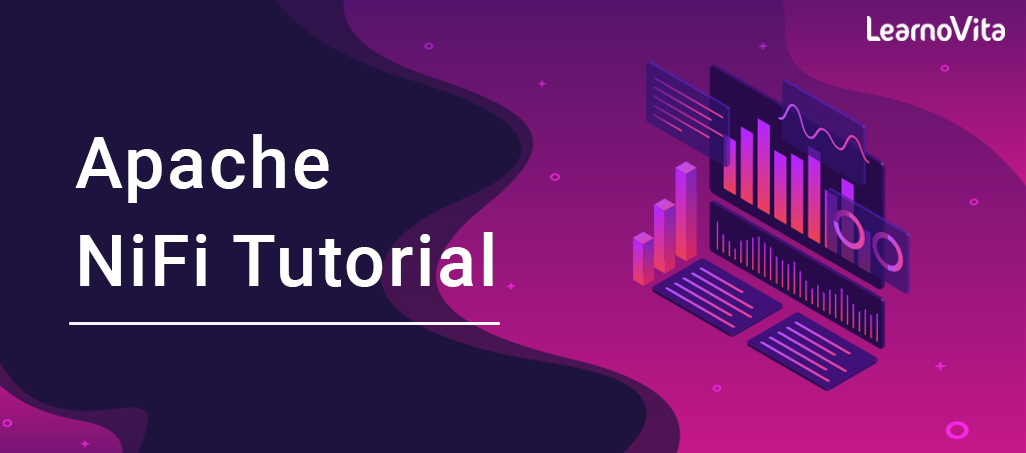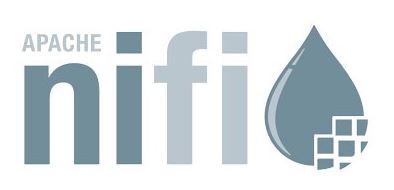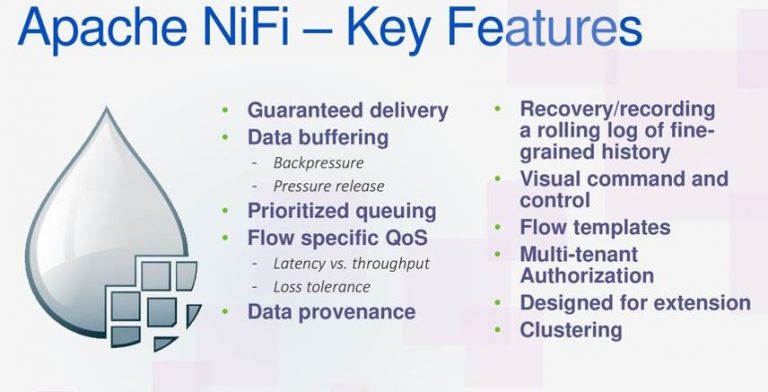
Apache NiFi (Cloudera DataFlow) | Become an expert with Free Online Tutorial
Last updated on 09th Aug 2022, Blog, Tutorials
What is Apache NiFi?
Apache NiFi is a robust, scalable, and reliable system that is used to process and distribute the data.
It is built to automatically transfer data between systems.
- NiFi offers a web-based User Interface for creating, screening, and controlling data flows.
- NiFi stands for Niagara Files that was developed by the National Security Agency (NSA) but now it’s managed by the Apache foundation.
- Apache NiFi is a web-based UI platform ,defining the source, destination, and processor for data collection, data storage, and data transmission, respectively.
- Every processor in the NiFi has relations that are used while connecting one processor to another.
Why do we use Apache NiFi?

ache NiFi is open-source; so, it is freely available in the market.
It encourages several data formats, such as social feeds, geographical location, logs, etc.
Apache NiFi supports a variety of protocols such as SFTP, KAFKA, HDFS, etc.
It makes this more popular in the IT industry.
There are many reasons to choose Apache NiFi. They are :
- Apache NiFi helps businesses to integrate NiFi with their existing infrastructure.
- It allows users to Java ecosystem functions and existing libraries.
- It provides real-time control that enables the user to follow the flow of data between any source, processor, and destination.
- It helps to view DataFlow at the enterprise level.
- It helps to aggregate, transform, route, split, listen, fetch and drag-and-drop the data flow.
- It allows users to initiate and terminate the components at single and group levels.
- NiFi enables users to pull the data from different sources to NiFi and allows them to make flow files.
- It is designed to scale out in clusters that provide warranty of delivery data.
- Displaying and screening performance, behavior in the flow bulletin that offers inline and insight documentation.
Features of Apache NiFi

- Apache NiFi is a web-based User Interface that offers a seamless experience of design, screening, control, and feedback.
- It even provides a data provenance module that helps to trace and screen the data from the source to the destination of the data flow.
- Developers can create their customized processors and reporting tasks as per the needs.
- It supports troubleshooting and flow optimization.
- It enables quick development and testing effectively.
- It provides content encryption and communication over a confidential protocol.
- It supports buffering of all queued data and provides an ability of backpressure as the queues can reach particular limits.
- Apache NiFi delivers a system to the user, the user to the system, and multi-tenant authentication confidential features.
Apache NiFi Architecture
Apache NiFi Architecture contains a web server, flow controller, and processor that runs on a Java Virtual Machine (JVM).
It has 3 repositories :
- 1.FlowFile Repository
- 2.Content Repository
- 3.Provenance Repository.
Web Server
Web Server is used to host the HTTP-based order and control API.
Flow Controller
The brain of the operation is flow controller
It offers threads for extensions to run and maintain the schedule of when the extensions receive resources to run.
Extensions
Several types of NiFi extensions are explained in other documents.
Extensions are used to operate and execute within the JVM.
FlowFile Repository
The FlowFile Repository includes the current state and attribute of every FlowFile that goes through the data flow of NiFi.
It records the state that is presently active in the flow.
The standard approach is the continuousWrite-Ahead Log which is placed in a described disk partition.
Content Repository
The Content Repository is used to save all the data present in the flow files.
The default approach is an easy mechanism that saves blocks of data in the file system.
To decrease the contention on any single volume, specify more than one file system storage location to get variety partitions.
Provenance Repository
The Provenance Repository is that all the provenance event data is saved.
The repository built is pluggable to the default implementation that makes use of one or more physical disk volumes.
Event data is indexed and searchable in every location.
Components of Apache NiFi
- Processor
- Input port
- Output port
- Process Group
- Remote Process Group
- Funnel
- Template
- Label
Processors Categorization in Apache NiFi
- AWS Processors
- Attribute Extraction Processors
- Database Access Processors
- Data Ingestion Processors
- Data Transformation Processors
- HTTP Processors
- Routing and Mediation Processors
- Sending Data Processors
- Splitting and Aggregation Processors
- System Interaction Processors
Advantages of Apache NiFi
- Apache NiFi uses the HTTPS protocol to ensure confidential user interaction.
- It supports SFTP protocol that enables data fetching from remote machines.
- It provides security policies at the process group level, user level, and other modules.
- NiFi encourages all the devices that run Java.
- It provides real-time control of easy movement of data between source and destination.
- Apache NiFi supports clustering so it can work on multiple nodes with the same flow processing different data, which improves the performance of data processing.
- NiFi supports over 188 processors, and a user can provide custom plugins to support different types of data systems.
Disadvantages of Apache NiFi
- In the case of a main node transfer, Apache NiFi has a state persistence risk that prevents processors from retrieving data from source systems.
- Making any modification by the user, the node gets disconnected from the cluster, and then flow.xml gets invalid.
- The node can’t connect to the cluster till the admin copies the .xml file manually from the node.
- You must be acquainted with the underlying systems in order to collaborate with Apache NiFi.
- It offers a topic level, and SSL authorization is not sufficient.
- It is required to manage a chain of custody for data.
Conclusion:
- On a final note, Apache NiFi is used for automating and maintaining the data flows between the systems.
- Once the data is fetched from the external source, it is represented as a FlowFile within the architecture of Apache NiFi.
Are you looking training with Right Jobs?
Contact Us- Hadoop Tutorial
- Hadoop Interview Questions and Answers
- How to Become a Hadoop Developer?
- What Are the Skills Needed to Learn Hadoop?
- Top Big Data Certifications for 2020
Related Articles
Popular Courses
- Apache Storm Training
11025 Learners - Git Github Training
12022 Learners - Apache Hive Training
11141 Learners
- What is Dimension Reduction? | Know the techniques
- Difference between Data Lake vs Data Warehouse: A Complete Guide For Beginners with Best Practices
- What is Dimension Reduction? | Know the techniques
- What does the Yield keyword do and How to use Yield in python ? [ OverView ]
- Agile Sprint Planning | Everything You Need to Know
